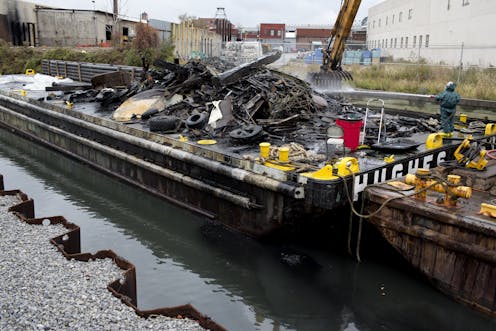How the EPA administrator protects public health, air, water and the environment
- Written by Stan Meiburg, Executive Director, Sabin Center for Environment and Sustainability, Wake Forest University

From the time you get up in the morning until you go to bed at night, and even while you are asleep, the U.S. Environmental Protection Agency[1] affects your life. The air you breathe, the water you drink, the chemicals under your sink, the car you drive, products you buy, food you eat and a host of daily routines depend on actions of the agency and the EPA administrator – the equivalent of a Cabinet secretary.
Since President Richard Nixon created the EPA in 1970[2], the U.S. population has grown by 62% and its gross domestic product has more than quadrupled. People in the U.S. drive almost three times as many miles now compared with then and use almost 50% more energy.
Yet, conventional air pollution emissions have declined by 78%[3]. Lakes and rivers are cleaner, chemicals are safer and hazardous wastes from past industrial activities have been cleaned up. This record shows that a clean environment can be compatible with economic growth.
Nonetheless, people’s views about the EPA tend to be highly polarized. Environmental advocates say the agency acts too slowly[4]. At the same time, conservatives accuse it of regulatory overreach[5]. The EPA administrator’s job is to embody the U.S. commitment to a clean and healthy environment, but the role has always been contentious – perhaps now more than ever.
Regulators and scientists
The EPA is the largest independent regulatory agency in the federal government, with a staff of about 16,850 and an annual budget of about US$10 billion[7]. The agency also received about $100 billion in special funding through the 2021 Infrastructure Investment and Jobs Act[8] and the 2022 Inflation Reduction Act[9] – at least some of which President-elect Donald Trump has said he wants Congress to repeal[10].
While the EPA’s headquarters is in Washington, D.C., it is a very decentralized agency. Almost half of its staff works in 10 regional offices[11] around the country, headed by political appointees who report directly to the administrator.
Other employees work in centers in Cincinnati, Ohio, and Research Triangle Park, North Carolina, and in laboratories around the country. EPA’s scientists support the agency’s standard-setting work and assist in finding and pursuing violations of environmental laws.
Nine of the EPA’s 16 administrators have been lawyers, two were former governors, five were former state environmental secretaries, and four held lower EPA positions earlier in their careers. These backgrounds highlight that the agency’s powers are based on interpreting and applying environmental laws and that doing so requires informed political judgment.
Regulation and litigation
The EPA’s work is driven by America’s major environmental laws[12], such as the Clean Air Act[13] and the Clean Water Act[14]. Most were enacted between 1969 and 1990, with a few significant amendments since then.
These statutes are highly prescriptive and set targets and deadlines that effectively dictate much of the EPA’s agenda. They vary in the degree to which they forbid, allow or require the agency to consider compliance costs for regulated entities.
Most of the laws contain broad citizen suit provisions[15], which give business and environmental groups ready access to the courts to either contest EPA actions or prod the agency to do more and move faster. Both Republican and Democratic EPA administrators have noted that their priorities could be driven by court orders[16] holding the agency to statutory deadlines[17] that it could not meet.
Even the most detail-oriented Congress doesn’t have the expertise or institutional capacity to specify every step needed to meet environmental goals. Environmental laws assign this responsibility to the EPA. Agency officials enact implementing regulations, following rulemaking procedures that are prescribed in federal administrative law[18].
The EPA is constantly sued over these laws and regulations. Cases often center on whether statutes actually contain the authority claimed by the agency. It is no accident that major concepts in administrative law have been articulated and debated in environmental cases.
One prime example is “Chevron deference[19]” – the principle that when faced with ambiguity in the law, courts should defer to reasonable agency interpretations of laws pertaining to their work. Chevron deference arose from a 1984 Clean Air Act case[20]; in 2024, the U.S. Supreme Court sharply curtailed it[21]. This ruling may significantly impair EPA’s work going forward.
The EPA’s actions are frequently contested before the Supreme Court. Recently, justices have limited the agency’s authority on issues including greenhouse gas emissions[22] and wetland protection[23].
President-elect Donald Trump sought to roll back environmental regulations in his first term and is expected to take similar action in his second term. However, most major shifts require congressional approval and are subject to legal challenges.Partnering with states
While the EPA has direct authority to enforce federal laws and regulations, most statutes provide for state environmental agencies to do the day-to-day work of issuing permits and enforcing laws. The EPA delegates this power to the states, on the condition that they have adequate legal authority and resources to do the work, and it oversees their activities.
The EPA also provides major funding to states[24], including operating grants that totaled about $1.2 billion in the 2024 fiscal year and capitalization grants for wastewater and drinking water infrastructure that totaled about $3.4 billion in that same 12-month period.
Finally, the EPA has an important role in responding to emergencies, such as the release of millions of tons of coal ash[25] into the Embry and Tennessee rivers in 2008; the Deepwater Horizon oil spill[26] in the Gulf of Mexico in 2010; the East Palestine, Ohio, train derailment and chemical spill[27] in 2023; and every major hurricane or extreme weather event. The agency’s emergency response work focuses on monitoring air and water pollution, cleaning up oil and chemical spills, and helping to restore water and sewer infrastructure.
Don’t expect to be popular
In addition to its interactions with the courts, the EPA receives a lot of attention from Congress. Fifty-one congressional committees and subcommittees have jurisdiction over various aspects of the EPA, and both the Government Accountability Office[28] and EPA’s own inspector general[29] regularly review the agency’s work.
The administrator’s decisions and public statements carry great weight for regulated industries and communities that are affected by pollution and toxic exposures. The EPA is subject to constant pressure from enormous and powerful interests and must balance these in countless ways – ideally, while upholding core values that William Ruckelshaus[30], the agency’s first administrator, outlined: Follow the law, follow the science and be transparent[31].
In the agency’s 54-year lifespan, almost all administrators have taken this responsibility seriously, even when it put them at odds with other agencies and sometimes with the president[32]. Running the EPA is not a job for anyone who wants to be politically popular or make everyone happy.
Nevertheless, the administrator is a critical player in maintaining a quality of life that Americans now expect the government to safeguard[33] and preserve for future generations.
This story is part of a series of profiles[34] of Cabinet and high-level administration positions.
References
- ^ U.S. Environmental Protection Agency (www.epa.gov)
- ^ President Richard Nixon created the EPA in 1970 (www.epa.gov)
- ^ have declined by 78% (gispub.epa.gov)
- ^ say the agency acts too slowly (insideepa.com)
- ^ regulatory overreach (www.foxnews.com)
- ^ EPA (www.epa.gov)
- ^ annual budget of about US$10 billion (www.epa.gov)
- ^ 2021 Infrastructure Investment and Jobs Act (www.whitehouse.gov)
- ^ 2022 Inflation Reduction Act (www.irs.gov)
- ^ has said he wants Congress to repeal (www.reuters.com)
- ^ 10 regional offices (www.epa.gov)
- ^ major environmental laws (crsreports.congress.gov)
- ^ Clean Air Act (www.epa.gov)
- ^ Clean Water Act (www.epa.gov)
- ^ citizen suit provisions (www.nelc.org)
- ^ court orders (www.epa.gov)
- ^ statutory deadlines (setac.onlinelibrary.wiley.com)
- ^ prescribed in federal administrative law (theconversation.com)
- ^ Chevron deference (theconversation.com)
- ^ arose from a 1984 Clean Air Act case (www.oyez.org)
- ^ the U.S. Supreme Court sharply curtailed it (theconversation.com)
- ^ greenhouse gas emissions (theconversation.com)
- ^ wetland protection (theconversation.com)
- ^ provides major funding to states (www.epa.gov)
- ^ millions of tons of coal ash (www.epa.gov)
- ^ Deepwater Horizon oil spill (www.epa.gov)
- ^ East Palestine, Ohio, train derailment and chemical spill (www.epa.gov)
- ^ Government Accountability Office (www.gao.gov)
- ^ EPA’s own inspector general (www.epaoig.gov)
- ^ William Ruckelshaus (www.epa.gov)
- ^ Follow the law, follow the science and be transparent (www.epa.gov)
- ^ sometimes with the president (www.nytimes.com)
- ^ expect the government to safeguard (news.gallup.com)
- ^ series of profiles (theconversation.com)
Authors: Stan Meiburg, Executive Director, Sabin Center for Environment and Sustainability, Wake Forest University



